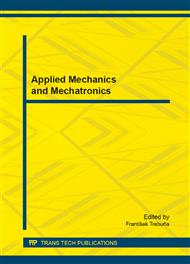[1]
G.A. Maugin, The thermomechanics of plasticity and fracture, Cambridge University Press, Cambridge, (1992).
Google Scholar
[2]
J. Lemaitre, J.L. Chaboche, Mechanics of solid materials, Cambridge university press, Cambridge, (1994).
Google Scholar
[3]
J. Lemaitre, Handbook of material behavior models, Vol. 1, Deformations of materials, Academic press, London, (2001).
Google Scholar
[4]
J. Lemaitre, Handbook of material behavior models, Vol. 2, Failures of materials, Academic press, London, (2001).
Google Scholar
[5]
J. Lemaitre, Handbook of material behavior models, Vol. 3, Multiphysics behaviors, Academic press, London, (2001).
Google Scholar
[6]
J. Simo, T.J.R. Hughes, Computational inelasticity, Springer, NY, (1998).
Google Scholar
[7]
S. Nemat-Nasser, Plasticity, A treatise on finite deformation of heterogenous inelastic materials, Cambridge University Press, Cambridge, (2004).
Google Scholar
[8]
C. Sansour, G. Kollmann, J. Bocko, A model of finite strain viscoplasticity with an anisotropic elastic constitutive law, Deformation and Failure in Metallic Materials, Springer, Berlin, pp.107-135.
DOI: 10.1007/978-3-540-36564-8_5
Google Scholar
[9]
L. Écsi, P. Élesztős, Moving toward a more realistic material model of a ductile material with failure mode transition, Mat. -wiss. u. Werkstofftech. 43, 5, (2012) 379-387.
DOI: 10.1002/mawe.201200969
Google Scholar
[10]
L. Écsi, P. Élesztős, Trying to model the thermo-mechanical behaviour of a solid body under cyclic loading using a material model with internal damping, Acta Mechanica Slovaca 12, 3-B (2008) 143-150.
Google Scholar
[11]
L. Écsi, P. Élesztős, Constitutive equation with internal damping for materials under cyclic and dynamic loadings using a fully coupled thermal-structural finite element analysis, Int. J. Multiphysics, 3 2 (2009) 155-165.
DOI: 10.1260/175095409788837829
Google Scholar
[12]
P. Rosakis, A.J. Rosakis, G. Ravichandrian, J. Hoodowany, A thermodynamic internal variable model for the partition of plastic work into heat and stored energy in metals, J. Mech. Phys. Solids, 48, (2000) 581-607.
DOI: 10.1016/s0022-5096(99)00048-4
Google Scholar
[13]
X. Lu, S.V. Hangund, A nonequilibrium irreversible thermodynamics model for material damping, Int. J. Solids. Struct, 44, (2006) 3278-3303.
DOI: 10.1016/j.ijsolstr.2006.09.021
Google Scholar
[14]
R. D. Cook, D. S. Malkus, M. E. Plesha and R. J. Witt, Concepts and applications of finite element analysis, 4. Ed., John Wiley & Sons Ltd., N.Y., (2001).
Google Scholar
[15]
L.C. Evans, Partial differential equations, American Mathematical Society, Providence, Rhode Island, (1998).
Google Scholar
[16]
L. Écsi, P. Élesztős, Extended NOIHKH model usage for cyclic plasticity of metals. Engineering mechanics, 13 2 (2006) 83-92.
Google Scholar
[17]
M. Šilhavý, The mechanics and thermodynamics of continuous media, Springer-Verlag, Berlin Heidelberg, (1997).
Google Scholar
[18]
I. Müller, Thermodynamics, Pitman publishing LTD., London, (1985).
Google Scholar
[19]
P. Haupt, Continuum mechanics and theory of materials, second ed., Springer-Verlag, Berlin Heidelberg, (2002).
Google Scholar
[20]
J.E. Field, S.M. Walley, W.G. Proud, H.T. Goldrein, C.R. Siviour, Review of experimental techniques for high rate deformation and shock studies, International Journal of Impact Engineering, 30 (2004) 725–775.
DOI: 10.1016/j.ijimpeng.2004.03.005
Google Scholar
[21]
J.F. Nye. Physical properties of crystals: Their representation by tensors and matrices. Clarendon Press. Oxford. (1957).
Google Scholar
[22]
J.R. Klepazko, A. Rusinek, Experiments on heat generation during plastic deformation and stored energy for TRIP steels, Materials and Design, 30 (2009) 35-48.
DOI: 10.1016/j.matdes.2008.04.048
Google Scholar
[23]
F. Trebuňa, F. Šimčák, Príručka experimentálnej mechaniky, Edícia vedeckej a odbornej literatúry, TypoPress, Košice, (2007).
Google Scholar
[24]
A. Služalec, An evaluation of the internal dissipation factor in coupled thermoplasticity, Int. J. Non-Lin. Mech., 25 4 (1990) 395-403.
Google Scholar
[25]
M.L. Pastor, X. Balandraud, M. Grédiac, J.L. Robert, Applying infrared thermography to study the heating of 2024-T3 aluminium specimens under fatigue loading, Infrared Phys. Techn, 51 (2008) 505-515.
DOI: 10.1016/j.infrared.2008.01.001
Google Scholar


